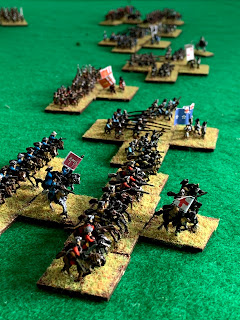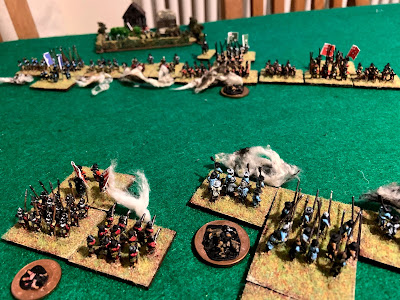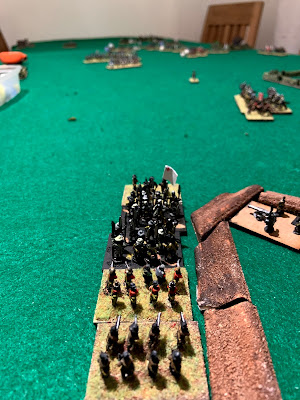Digression: in primary school at break times, if we wanted to play war/cowies & indies we would start with a call to arms. The initial cadre would stand side by side, arms over each other’s shoulders, then proceed to march across the playground chanting “who wants to play at War? No girls allowed!” Volunteers would join the line in turn and the line would continue marching and chanting. I have to this day no idea how we would decide when the recruitment stage had finished and we could proceed to the game. Looking back it appears as if it was just something we intuitively agreed upon. Taking sides was the next phase, and this was largely decided by self-selection, and this naturally led to many on the ‘goodies’ side and a pitiful number of 'baddies'. The odds were evened up by allowing the undermanned baddies extra lives. Occasionally a more assertive boy would insist on some poor sap having to go on the baddies side. As an occasional exception to the “no girls allowed” rule, girls could be allowed to play as the Indians. After all, they had long hair, had no idea about military discipline and could not make good gun noises so were better suited to imaginery bows and arrows. Later variants on the games would include Romans v Greeks, Saxons v Vikings and Normans v Saxons, all after watching BBC TV for schools history programmes in class. I remember being virtually the sole Greek volunteer. I wonder if our pre-game recruitment method was just something we did at our school or was it more widespread?
Outfits in my case came courtesy of my mum’s dad, a deep sea trawlerman who was always generous, especially after a good trip. And there were plenty of good trips in those days. The crews of trawlers were classed as ‘casual’ workers (a ludicrously inappropriate description for a job of such long hours and danger) were paid a relatively small fixed amount but had a share in the catch which frequently turned them into ‘3-day millionaires’. Three days because they were often only home for that amount of time before returning to sea.
Half crowns (12.5 pence in modern money) were common currency after Granda's trips, and this funded a growing collection of Timpo cowboys and Indians, and later Airfix toy soldiers. Christmas and birthdays meant a succession of outfits, bikes and scooters. There was a range of outfits using the brand Billy Best and at different times grandad bought me cowboy, soldier (modern) and spaceman outfits. Other, home made, outfits included Robin (my big brother was Batman naturally) and Robin Hood and his Merry Men (complete with home made bows and arrows). So far so good. All fairly normal (we'll gloss over the costumes my sisters made for Batman and Robin).
Now I’m very hazy on the timing here. I’m not sure what came in what order, but at around the same time I took to wearing hats of whatever type took my fancy on other occasions. I don’t mean things like balaclavas or sun hats that had a practical application, but my play hats. I have an old picture of me with two of my sisters on the prom at Scarborough, holding a tiny monkey with me in a US navy style hat. Re-reading that back now it sounds more camp than it was. I was not sporting a Jean-Paul Gaultier stripey top. My mother’s youngest brother was then a rating in the Royal Navy and he gave me his hat from HM Bloody Big S. He would drop off other hats that he acquired on his travels from time to time - my favoured titfer being a bush hat acquired from somewhere out in the Far East. The HM Bloody Big S hat never left the house as it was too splendid for mere play and more importantly, too big to stay on my bonce.
 |
| Photograph by Isaac Newton of a Bloody Big Ship from Wikipedia. |
The same uncle used to come back with an array of exotic loose change after his trips, so foreign coins became another collection. This really was a ‘collection’ as opposed to something I had rather a lot of. It served no practical purpose. It was just for looking at and organising. I certainly wasn’t going to play shops with it - girls games, yeugh! I think my favourites were some small Danish coins with holes in the middle and a Kenyan shilling. The Danish coins could well have turned up in Grimsby rather than on some naval posting, as the town was a port of call and eventually home to a lot of fishermen and other merchants sailors from Denmark in the 20th century. Quite appropriate given the place's origins.
So hats, toy soldiers and foreign coins. Added to that was what became a vast (over 100) collection of badges. I have no idea how this started. The sort of badges I had were a random assemblage of company marketing tat (Eskimo Frozen Foods anyone?) and hippy type slogans. One of my main sources being my eldest sister (by then mid-to-late teens). These badges were typically tin or some cheap metal, round, about an inch in diameter and with a safety-pin type, erm, pin on the back. Rather like this: https://www.ebay.ie/itm/Vtg-Badge-Eskimo-Frozen-Foods-Fish-Advert-Advertising-1960s-Promotion/223793975200?hash=item341b290fa0:g:DfoAAOSw7iZd88cF It seems on reflection that my sister was always encouraging me to adopt hobbies of one sort of the other (see other posts about her influence on me with regard to football, wargaming and real ale).
OK, badges were still fairly ordinary as a collection. Indeed, noting the e-Bay Ireland link above some people are still collecting them. But bottle tops?* The sort that you have to lever off with a bottle opener, not screw caps. This collection grew and grew, although there were many duplicates. Quality or uniqueness was not of overriding importance to me. I remember as a small boy my siblings trying to tell me that I already had a Pepsi bottle top but I simply would not part with the surplus examples. So the collection was a hoard really. An evolutionary psychologist would have had a field day.
* I thought I was weird but a quick look on the aforementioned auction site suggests it's alive and kicking as 'a thing'. And who am I to call others weird? I play with toy soldiers.
Ultimately the collection of collections reduced over time to just one. The toy soldiers. That grew and grew. Before shrinking in number when I transferred from plastic to metal, and then growing again in number when I switched to a smaller size of toy.






















